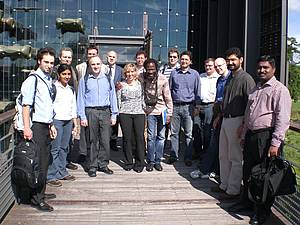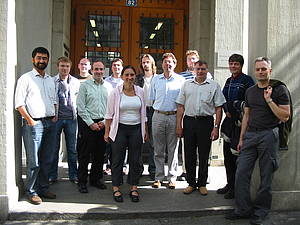Abstract
Atomic force microscopy (AFM) has proven to be a powerful tool to investigate frictional forces of nanoscale contacts. Unfortunately, this technique reveals some drawbacks when applied to study chemical and structural properties of two rubbing surfaces. The tips used in AFM are prefabricated. Consequently one of the two rubbing surfaces usually consists of a silicon compound and the effective size of the contact will be mainly determined by commercially available tip radii. However, urgent current questions concern the contact area dependence as well as the influence of the material on tribological properties. The contact area dependence of friction is crucial in bridging the gap between nanoscale and microscale friction, which eventually will allow us to understand and control macroscopic friction. The right choice of materials, on the other hand, is expected to lead to new friction effects, like, e.g., superlubricity.
A solution of this problem is to use the AFM as a manipulation tool, through the controlled pushing of nanoparticles on the surface. In this case the properties of the surfaces and the nanoparticles can be chosen from a wide range of material combinations. The AFM tip is then used to push the individual particles along predefined pathways, while simultaneously evaluating the frictional forces. Apart from answering long-standing questions regarding fundamental issues in nanoscale tribology, these studies will be able to address issues of controlled motion of the particles for practical applications.
In this cooperative research project we propose to investigate these effects systematically, addressing nanoparticles with different sizes, shapes and functional groups on their surfaces, as well as substrates with different roughness, structure and chemical composition in different environments, from liquids to ultrahigh vacuum. The experimental studies are harmonized with theoretical investigations concerning the manipulation process itself, as well as the interfacial atomic processes during particle translation.
Consortium
Project Leader:
Dr. André Schirmeisen
Department of Physics, Insitute of Physics, University of Münster, Münster, Germany
Principal Investigators:
Professor Rogerio Colaço
Department of Material Engineering, Instituto Superior Tecnico, Technical University of Lisbon, Lisbon, Portugal
Dr. Rynno Lohmus
Institute of Physics, University of Tartu, Tartu, Estonia
Professor Peter Reimann
Faculty of Physics, University of Bielefeld, Bielefeld, Germany
Professor Ivan Stich
Department of Physics, Center for Computational Materials Science (CCMS), Slovak University of Technology (FEI STU), Bratislava, Slovak Republic
Associated Partners:
Dr. Donats Erts
Institute of Chemical Physics, University of Latvia, Riga, Latvia
Dr. Enrico Gnecco
Institute of Physics, University of Basel, Basel, Switzerland
Professor Karine Mougin
CNRS, Institut de Chimie des Surfaces et Interfaces, Mulhouse, France
Professor Udo D. Schwartz
Department of Mechanical Engineering, Yale University, New Haven, United States
News
The second NANOPARMA Meeting took place at the National Car Museum Schlumpf Collection in Mulhouse on 16 June 2009.

The NANOPARMA CRP has achieved the following publications:
1. A. Rao, E. Gnecco, D. Marchetto, K. Mougin, M. Schönenberger, S. Valeri and E. Meyer, "Analytical relations between particles and probe trajectories in AFM nanomanipulation, Nanotechnology 20 (2009) 115706
2. K. Mougin, E. Gnecco, A. Rao, M.T. Cuberes, S. Jayaraman, E.W. McFarland, H. Haidara and E. Meyer, "Manipulation of gold nanoparticles - Influence of surface chemistry, temperature and environment (vacuum vs ambient atmosphere)", Langmuir 24 (2008) 1577
The kick-off meeting of the NANOPARMA Project took place in Basel Switzerland on 8 September 2008.



